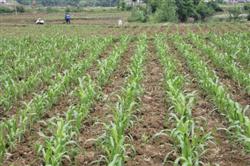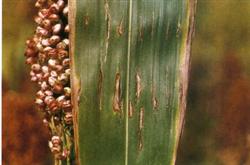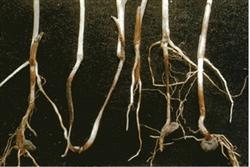How to control weeds in sorghum fields?

How to control weeds in sorghum fields? Please introduce the method weed is a major disaster in sorghum production, it competes with sorghum for water, fertilizer, glory and land, resulting in a decline in the yield and quality of sorghum. Grass damage in low-lying land and saline-alkali land is particularly serious, and it is annual, that is, there will be weeds at any time. The harm of weeds to sorghum is mainly in the seedling stage, during which the cultivation of strong seedlings is extremely disadvantageous, and some plots often destroy seedlings or reduce yield because of grass damage. There are hundreds of weeds harmful to sorghum, which are different in appearance, ecology, reproductive habits, hazard characteristics and sensitivity to herbicides. Therefore, the prevention and control of grass damage should be controlled flexibly according to the species of weeds and local cultivation habits. The main prevention methods are as follows: 1. Deep tillage is one of the effective methods to control weeds. The seeds of most weeds germinate well within 1 cm of the soil surface, and the deeper ploughing is, the more disadvantageous it is for weed seeds to germinate. For example, Liriodendron frutescens germinates well within 1cm and 3cm, but cannot germinate below 5cm. The weed propagation coefficient is quite large. One plant of Artemisia annua can produce 500000 seeds and purslane can produce 200000 seeds. After deep ploughing, a large number of seeds can be turned into the deep soil, so that they can not germinate and reduce the harm of weeds. two。 Rotary tillage before sowing can effectively eliminate a large number of weeds sprouting on the surface of the soil, thus reducing the number of weeds in the field. Rotary tillage can eliminate perennial perennial root weeds, such as Bermudagrass, destroy the apical dominance in the rotary tillage layer of deeper perennial root weeds, postpone the damage of weeds to sorghum, and is beneficial to the cultivation of strong seedlings. 3. Mid-tillage can directly eliminate weeds. In fields with less grass damage, mid-tillage is an effective measure to eliminate weeds. However, in manual and semi-mechanized operation, mid-ploughing and weeding often accounts for more than half of the whole field management labor, and the efficiency is low, labor intensity is high, and it is very hard. In places where grass damage is heavy and manpower is tight, it is often easy to cause grass shortage due to lack of labor. 4. Chemical weeding is an economical, effective, safe and low-cost method that people find out in the practice of fighting against weeds. Production practice has proved that chemical weeding has the advantages of timely weeding, good effect, light labor intensity, high work efficiency, low cost and so on. The application of chemical weeding can achieve higher economic and social benefits. With the development of agricultural modernization in China, chemical weeding technology will be more and more accepted by the majority of agricultural development in our country, and chemical weeding methods will be developed and applied more and more rapidly, thus changing the backward technology of field management for thousands of years. Bring greater benefits for farmers and society. Chemical weeding is mainly carried out in the two periods from sowing to emergence and 5-8 leaves after emergence. The specific usage and pesticides are as follows: (1) after sowing, Zhi Zhi uses chemical weeding before sowing and chemical weeding from sowing to emergence. Before the seedlings are unearthed, herbicides are sprayed, and the weeds that germinate early will die quickly after being treated with the medicine. That is, chemical weeding is carried out by making use of the difference in the germination time of seeds and weeds. Sorghum is very sensitive to chemicals, and must strictly control the variety, time, concentration and method of drug use, otherwise, it is easy to cause drug damage. The common chemical weeding methods before seedling after sowing in sorghum field are as follows: first, use 25% chlorotoluron wettable powder 200g / mu, spray 50 liters of water evenly on the soil surface. Second, use 150 grams of 25% green Malon wettable powder per mu, add 150 milliliters of 50% herbicide (also known as herbicide, herbicide, rice straw) EC, or add 50 milliliters of butachlor (also known as methachlor, methachlor, decachlor) 50 milliliters of water, spray the soil surface. Third, use 80% herbicide (also known as thatch poison, methyl carboxyl herbicide) wettable powder 75 grams per mu, 35 liters of water, spray the soil surface. In case of drought, you can rake 2cm to 3cm, so that the liquid mixed with soil, increase with weeds,? Grass contact opportunity. Fourth, spray the soil surface with 72% metochlor (also known as Metolachlor) EC 100ml / mu, about 35 liters of water, or spray the soil surface with 75ml dour, plus 40% atrazine (also known as atrazine) colloid 100ml. Fifth, use 50% Liguron wettable powder 150 grams per mu, 40 liters of water, spray the soil surface evenly. Sixth, use 50% per mu to extinguish 200 grams of Tianjin wettable powder, 40 liters of water, and evenly spray the soil surface. Seventh, per mu with 48% Baicaodui (also known as wheatgrass) water agent 250ml, 35 liters of water, or Baicaodi 20ml 30ml plus 40% atrazine glue suspension 150ml 300ml, or 48% alachlor (also known as Rasol, grass not green) EC 200ml 300ml, 35 liters of water, spray the soil surface. Eighth, spray the soil surface evenly with 72% 2 minutes per mu, 50% 80 milliliters of fat EC and 35 liters of water. Ninth, per mu with 40% simazine glue suspension 20000ml, 40 liters of water, evenly sprayed soil surface. Note that the residual period of this drug is long, and it is not suitable for subsequent crops to arrange crops such as wheat, rape and soybeans. when corn and sugarcane are arranged in the next crop, the dosage can be increased to 500 ml. (2) Chemical weeding at seedling stage Chemical weeding at seedling stage is to use different biochemical processes of herbicide metabolism in crops and weeds to achieve the purpose of weeding and seedling protection. At 5-8 leaf stage after emergence, sorghum has strong resistance to herbicides and is safe to use herbicides, but before 5 leaves and after 8 leaves are very sensitive to herbicides, so chemical weeding at seedling stage is generally carried out at 5-8 leaf stage, otherwise, it is easy to cause drug damage. Chemical weeding of sorghum is mostly carried out before emergence, and it is generally not suitable to spray herbicides at seedling stage. If the grass damage is serious at the seedling stage, the spraying time, concentration and variety should be strictly controlled. The commonly used chemical weeding methods at the seedling stage are as follows: first, at the 4-5-leaf stage after the emergence of sorghum, the use of 72% 2 min 4m D.J ester EC 40% 65 ml per mu, about 35 liters of water, evenly sprays the stems and leaves of weeds, mainly to control broad-leaf weeds and Cyperaceae weeds, but not to Gramineae weeds. Second, sorghum seedlings after 4-5 leaf stage, per mu with 40% atrazine glue suspension 200 million 250 ml, 35 liters of water, evenly spray weed stems and leaves. It can control monocotyledonous and dicotyledonous weeds and deep-rooted weeds. Third, sorghum seedlings after 4-5 leaf stage, per mu with 20% dimethyltetrachlorohydrin 100 ml and 48% Baicao water agent 12.5 ml mixed, 35 liters of water, evenly spray weed stems and leaves. Herbicides in the above responsibilities can also be used alone, and the concentration should be doubled. Click to get more sorghum planting technology click to get more grain planting technology
- Prev

What are the symptoms of sorghum bacterial red streak?
What are the symptoms of sorghum bacterial red streak? Please introduce that the symptoms of sorghum bacterial red streak disease are mainly harmful to leaves. At first, the leaf spot showed a small, narrow, watery spot, and after expansion, it became light reddish brown. Some plaques turn brown in the center and red on the edges, and wide long oval spots appear intermittently on the stripes. There is.
- Next

What is sorghum charcoal rot? How to prevent?
What is sorghum charcoal rot? How to prevent? Please give an introduction to sorghum charcoal rot symptoms: sorghum whole growth period can come on. Infection with the disease can lead to withered seedlings or charred roots. The infected roots were initially water-stained, then blackened, internal tissues collapsed, cortex rotted and extended to lateral roots. Infected plants mature early, ears...
Related
- The first cup of black tea in spring, the flavor and history of tea gardens in Kenya, Africa
- The computer can not only choose potatoes, but also grow tea rice. AI will grow winter oolong tea champion.
- It is not only the inflated tea bitten by insects, but also engraved with the four seasons tea in Beipu.
- The Oriental Beauty Tea Festival in Zhuxian County takes the stage at the weekend to experience the plus-size feast of oil tea.
- & quot; Oriental Beauty Tea & Exploration of Emei in Hsinchu, the hometown of quot;
- The new variety of strawberry "Tainong 1" dessert is the first choice with mellow aroma. Crimson gorgeous
- History of Tea in Taiwan: from Wild Inner Mountain to Export Tea Garden
- Two types of Taiwan Oriental Beauty Black Tea won the British three-Star Award for Childhood Tea Xiang Zhang Jiaqi changed from pilot to champion tea maker.
- Banana species and varieties: the planting history of Taiwan Xianren banana and dwarf banana is long, is banana disease resistant?
- Coffee planting Technology: Qianjie Coffee from Seedling to harvesting

